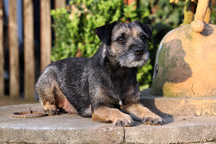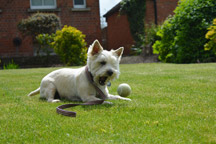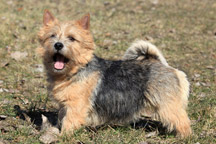Are Affenpinschers Hypoallergenic?
Indeed they are! Having a low-shedding coat and with little propensity to drool makes them perfect for allergy sufferers!
The Hypoallergenic Affenpinscher
With a confidence that’s off the scale, a hunger to explore, and a face that you can’t help but love—the Affenpinscher makes for a highly desirable hypoallergenic doggie.
Unless you’re going to opt for a virtually fur-free pooch, such as a Chinese Crested Dog, a canine coat can be the cause of unwanted sniffles and sneezes. And, although performing a drastic haircut on your doggie may help your intolerances—you will likely end up with a slightly strange-looking pooch—and one with serious self-image issues.
Luckily, the Affenpinscher doesn’t require such an extreme measure.
Not only does this personality-laden pooch shed little fur—a bonus for your allergies and your furniture—but it’s also extremely slow growing. This means that—unlike a movie star shopping on Rodeo Drive—it doesn’t gain a new fur coat every few weeks.
Furthermore, its hairy outer jacket acts like a net.
Due to the fur’s dense and wiry nature, it retains dander—the dead skin cells that can spark off an allergic reaction. Naturally, you’re going to have to brush this out occasionally—unless you want your Affenpinscher looking like it has a severe case of dandruff—but it will not be covering your cushions or floating in the air.
And, the Affenpinscher has one more allergy-busting characteristic.
It doesn’t slobber.
While slavering may add to a doggie’s cutey factor—it’s a nightmare for your intolerances. Proteins in canine spit can set off cases of asthma, eczema, rashes, and sniffles. And—as this saliva can be left as small presents on your bed, carpets, and sofa—it can be difficult to avoid.
Luckily, the Affenpinscher likes to keep its doggie drool in its mouth—lowering the chance of activating your allergies.
The bottom line—the affable Affenpinscher is a wonderfully hypoallergenic dog.
Are Affenpinschers Hypoallergenic Dogs? Contents
Affenpinscher Quick Facts
About the Affenpinscher
The Story of the Affenpinscher
Physical Characteristics and Coat of the Affenpinscher
Affenpinscher Temperament
Affenpinscher Grooming and Care
Affenpinscher Training and Exercise
Training Your Affenpinscher
Affenpinscher Health Issues
Conclusion
Affenpinscher FAQs
Affenpinscher Fact Summary
Affenpinscher Quick Facts
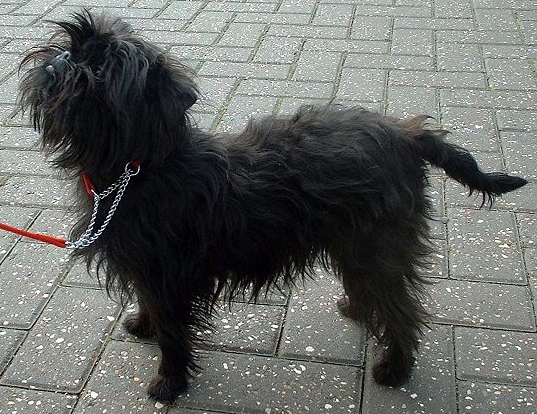
The name Affenpinscher translates (from German) as monkey dog—and whether that relates to their ape-like appearance or their mischievous nature—it’s perfectly apt.
And, while it may appear that this comical pooch was bred to be a stand-up comedian, its history is much more down to earth.
The Story of the Affenpinscher
Back in the 1600s, the Germans had something of a rat problem, perhaps due to the fact the Pied Piper of Hamelin had stormed off in a huff over payment of an invoice (although he did steal all their kids in retribution—so I guess that’s fair).
Ok, the Pied Piper part may not be true—but the disease-infested rodents were indeed taking over many townships.
While the British solved this problem by breeding terriers—such as the Norfolk and Yorkshire—the Germans nurtured the Affenpinscher. While originally kept in barns and outhouses to eliminate the vermin, the German Hausfraus eventually brought them into the kitchen to exterminate the equally annoying mice.
Whether it was their hilariously adorable face (the Affenpinscher’s, not the German housewives) or their loyal and lovable nature—these rat terminators soon became members of the family.
Over the years, the Affenpinscher gained popularity and—while losing its raison d’etre as a ratter—it never lost his tenacious spirit. However, it began to climb the social strata and, by the early 1920s, this pooch became one of the must-have fashion accessories for German actresses.
Perhaps its pinnacle of fame occurred when the last private owner of the Hope Diamond, Evalyn Walsh McLean, took an Affenpinscher back to the USA. Not only does Ms. McClean appear in numerous photographs—with both her prized doggie and her diamond—she would often attach this incredible rock to her pooch’s collar and parade it around her grounds.
Seeing movie stars and socialites with the Affenpinscher—the hoi polloi decided they wanted to be in on the action. Soon, Affenpinscher clubs sprang up throughout Europe, most prolifically in Germany and France.
Ultimately, in 1936, the AKC (American Kennel Club) decided that this one-time rat-dog deserved to join its ranks.
Physical Characteristics and Coat of the Affenpinscher
The French, a nation that’s never been afraid to call a spade a spade (or une bêche une bêche), christened the Affenpinscher the diablotin moustachu—the mustachioed little devil.
And looking at its face, you can see why.
Sporting a ‘tache that wouldn’t look out of place on a German/Prussian 19th-century soldier—the Affenpinscher initially carries an air of dignity and strength—which is then rapidly undermined by its shaggy coat and laughing eyes.
Although small, measuring 9-11.5 inches and weighing around 7-10 pounds—the Affenpinscher is compact, solid, and sturdy—built for battling those voracious vermin. Its ears can be erect or dropped—both are considered perfectly acceptable by the major canine clubs.
The pooch’s head is small, domed and round, adding to the Affenpinscher’s cute demeanor. Sometimes the lower jaw can be a little undershot—enhancing its monkey-like appearance.
And now, the important feature—the coat.
Look at any Affenpinscher show-champion photographs and one aspect stands out immediately—it looks as if they forgot to attend their appointment at the barbershop. The kennel clubs around the world accept that the scruffy appearance of the Affenpinscher is part of its appeal—and have made no attempt to tone it down.
What’s more, it would be an exercise in futility.
The rough and wiry fur would be virtually impossible to tame. But as I already mentioned, its slow-growing and dander-retaining features mean it’s ideal for allergy sufferers. The fur grows to a length of around an inch across the upper body—although the legs, head, and stomach may sport a longer length.
Usually, the coat is colored as follows:
- Black.
- Gray.
- Silver.
- Red.
- Black and tan.
- Beige.
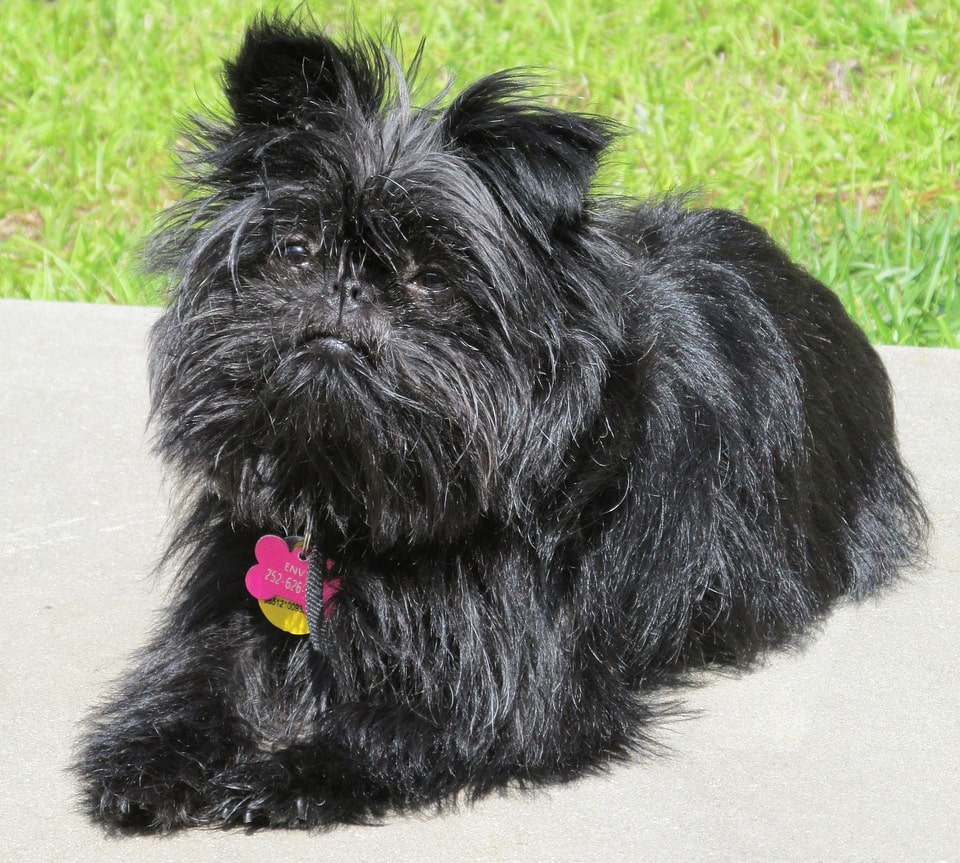
Affenpinscher Temperament
With an air of self-importance and confidence that’s completely out of proportion to its size, the Affenpinscher is like the Instagram influencer of the doggie world.
This pooch isn’t afraid of anything—at all.
While as placid as anything at home with his family, should it—or you—become threatened, it will fearlessly stand up to any threat—whatever the size of the aggressor.
The renowned zoologist and author, Desmond Morris, wrote in his book, Dogs (2001), that while vacationing in Alaska, he witnessed an Affenpinscher scaring away a Grizzly Bear.
However, with its pet parents, the Affenpinscher is nothing but loving. Highly affectionate, these doggies are utterly loyal. And, as long as you don’t give in to their demands—will completely idolize you.
They mix well with other pooches and cats—but don’t leave them near small rodent pets, such as gerbils and hamsters. However much you train your Affenpinscher, inherently it’s a hunter—and will see those tiny creatures in cages as nothing but prey.
Additionally, they’re not ideal for families with small children. As I’ve mentioned, they’re not aggressive and won’t seek out a confrontation with tiny tots. Yet, a young Affenpinscher may misinterpret childish playfulness and rough-and-tumble as a threat—and respond with barking, growling, and bared teeth.
Furthermore, they can be proprietorial when it comes to their food and toys—meaning that they will not take kindly to your two-legged tots touching their possessions.
This territorial behavior could also extend to your home. Affenpinschers may bark at strangers entering your living room—but once you have made the necessary introductions, this typically ceases. That said, these cautious canines will keep a watchful eye on the house invaders until they leave—usually letting out a couple of short barks when the ‘foreigners’ depart—almost saying, “yeah, and don’t come back”.
Loving attention, company, and the reassurance and safety that your ‘pack’ provides—Affenpinschers aren’t great when left alone. Hence, if you’re out at work for extended periods, it may be worth considering an alternative small hypoallergenic dog.
Unless you plan on showing your Affenpinscher, the cheeky little mite will only need grooming twice a week.
First, pass a brush through the coat to tease out the hair from any tangles. Once complete, use a fine comb—such as those for greyhounds—to separate the fur and remove any trapped dander.
Although not as liable to matting as some pooches, such as the Cockapoo, the undercoat can form into little clumps. Remove these awkward areas by hand, to avoid causing your Affenpinscher any pain.
It’s important that you pay particular attention to the head, to ensure this longer fur doesn’t impair the doggie’s eyes, nose or mouth, but gives the tiny terror his distinctive appearance.
Brush the hair forward over your Affenpinscher’s face—and then cut a V-shape to reveal its enchanting eyes. Trim the hair on the nose bridge into a fan to prevent this interfering with the pooch’s vision.
Even with basic hairdressing skills, this scissor action isn’t challenging—and only requires attention every three months or so.
Cut back their nails every couple of weeks—or when you can either see them becoming too long or hear the tell-tale clippety-clap sound on tiles or concrete. In addition, a couple of intense teeth-brushing sessions per week will ensure that your Affenpinscher has healthy gnashers and gums.
As the Affenpinscher size is just 9 to 11.5 inches—and with relatively small legs—these doggies will thrive in small homes or apartments. While an outside play area is always a bonus—as it gives the pooch a chance to amuse itself while you’re busy—it’s not essential.
That said, you can’t just keep your Affenpinscher cooped up!
The AKC rates them as a ‘moderately active’ breed—meaning they require one to two brisk walks per day. Around 20 minutes per stroll is sufficient—but treat that as a minimum!
If you take it steady, the Affenpinscher will happily walk with you for a couple of hours without becoming overtired. Although, as they are quite compact, they don’t make good running companions.
In addition, I also recommend a little bit of daily indoor play—which can be as much fun for you as your fur baby. Fetch (if you have the room) and tug-of-war are ideal games for small apartment owners.
If it’s safe to do so, and your Affenpinscher has responded well to obedience training, there’s nothing stopping you from letting your prized puppy off the leash for some park play. While a ratter, they don’t suddenly develop tunnel vision if they spot a bird or squirrel—unlike the Norwich Terrier, for example.
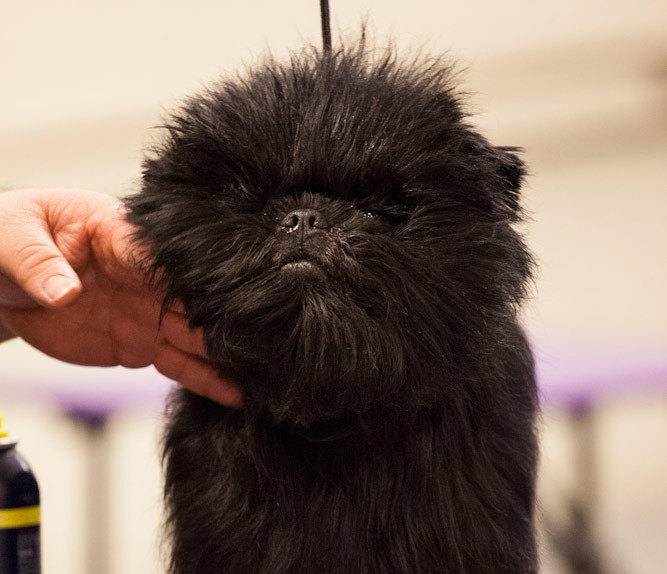
Affenpinschers are intelligent—which is, unfortunately, to their detriment when training.
They often develop a huge ego—and think that they know best. While their independent-mindedness should be admired, it can make teaching your pooch obedience somewhat challenging.
Furthermore, their clever nature means that they have an active interest in everything going on around them. Hence, Affenpinschers can become quickly distracted. You might be repetitively instructing him to sit—but that new cushion on your sofa hasn’t been sniffed yet—so it will happily wander off to investigate.
However, there is some good news.
Being phenomenally loyal—and thinking the absolute world of their pet parent—they do want to please.
Just remember that unless they’re constantly stimulated during training, they will rapidly become bored and either disappear or lay on the floor and ignore you. So, keep your lessons short. Little and often is more productive with an Affenpinscher than longer, more intense sessions.
Generally speaking, the Affenpinscher is an incredibly healthy dog. In 2015, the official breed club, the Affenpinscher Club of America, stated that:
‘Affenpinschers, to date, have no known inherited illness, deformity, or genetic malfunction specific to the breed.’
However, with their small and compacted noses, they can develop breathing issues if over-exercised—so you need to take care not to push your pooch to the limit.
Furthermore, if respiratory problems start, this can restrict the Affenpinscher’s ability to pant—which can induce overheating.
While there are no diseases specific to the breed, there are three health issues that are commonly seen in Affenpinschers.
Legg-Calvé-Perthes Disease
With this condition, the head of the femur bone in the hind leg degenerates. This leads to both the hip joint breaking down and osteoarthritis.
The cause of Legg-Calvé-Perthes Disease is unknown—although it’s suspected to be due to blood-supply problems to the bone itself. Most commonly, this is seen in small dog breeds, including the Affenpinscher.
Signs of this condition include lameness, carrying the affected leg, and pain when moving the hip joint. A veterinarian will diagnose the disease by means of an X-ray, with treatment ranging from rest and painkillers, through to surgery.

Patellar Luxation
Unfortunately, Affenpinschers can develop floating kneecaps or, in medical terms, patellar luxation. This describes a situation where the pooch’s kneecap slips from its correct position.
In very serious cases, the movement of the knee can be visible to the naked eye. However, more usually, pet parents identify that there’s an issue when the dog walks with one leg in the air, limps, or has issues with running.
Sometimes this can happen when your Affenpinscher lands awkwardly or knocks into a piece of furniture. When this happens, the treatment prescribed by a veterinarian is often a painkiller to make the doggie more comfortable, plus an anti-inflammatory.
However, if the knee slips too often, or is constantly misaligned, your canine specialist may recommend a surgical procedure.
Hip Dysplasia
In most circumstances, as your Affenpinscher grows from a puppy into an adult, the bones all grow in a uniform manner. However, sometimes, the ball of the femur and hip socket develop at different rates—meaning that the leg isn’t secure in the hip.
Hence, the joint never sits correctly, or frequently dislocates—a condition known as hip dysplasia.
Pet parents typically notice there is an issue when their Affenpinscher is unwilling to go on walks, spends an extensive amount of time sitting down, or expresses squeaks of pain when moving. Additionally, they can develop a type of gait similar to a bunny hopping.
If at any time you notice these characteristics signs, take your pup to see the vet. He or she may suggest weight control, medication, or a surgical procedure—depending on the severity of the case.
Known as the monkey terrier—the Affenpinscher is as adorable, intelligent, and mischievous as its name suggests.
Loyal, affectionate, and lively—they make ideal family pets. And due to their compact size, they’re perfect for apartment or small home life.
That said, the Affenpinscher isn’t suitable for prospective pet parents with very young children. And, their stubborn and easily-bored nature can make them challenging to train.
However, for those with intolerances to puppy hair, they’re fantastic.
With a slow-growing coat that hardly sheds, wiry fur that retains dander, and no slobber or drool—the Affenpinscher hypoallergenic pooch is a wonderful companion for allergy sufferers.
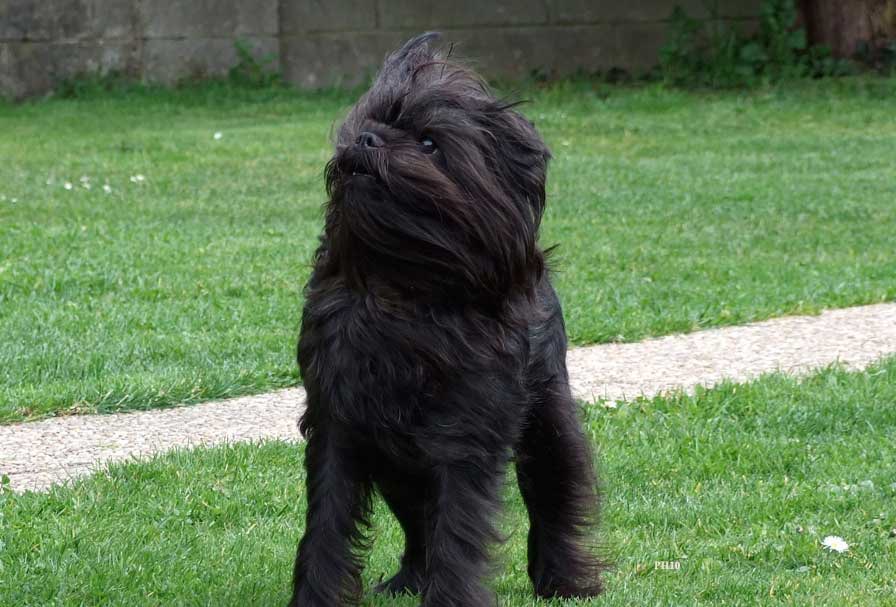
Is Affenpinscher a Good Family Dog?
The Affenpinscher temperament is loyal, loving, and protective of its pet parents and two-legged siblings—hence making it an excellent family dog. Additionally, these dogs are perfectly happy living alongside other pooches and felines.
However, I don’t recommend them for families with small children—these doggies can sometimes misinterpret rough-and-tumble as threatening behavior.
What Are the Affenpinscher Colors?
The standard colors for the Affenpinscher are black, black and tan, gray, red, silver, and beige.
Sometimes, the black varieties may sport a little area of rust, or white or silver hair mixed in with the coat. Lighter-colored Affenpinschers may have an adorable and cute black mask.
Is the Affenpinscher a Terrier?
Translated from the German, the name Affenpinscher means monkey-terrier—but that is incorrect.
It would be true to say it is terrier-like—with its active nature, small frame, and proclivity for hunting. However, it’s classed as a Toy by the AKC—not a terrier.
Are Affenpinschers Smart?
Incredibly. This clever canine is inquisitive, a problem solver and shows interest in anything new they see.
However, this intelligence does mean they can become easily bored and distracted during training lessons. Hence, patience is required when teaching your Affenpinscher.
How Big Does an Affenpinscher Get?
A typical Affenpinscher will grow to 9-11.5 inches high and weigh around 7-10 pounds.
Do Affenpinschers Shed?
While all dogs drop hair, the Affenpinscher shedding rate is extremely low. Furthermore, their coat is slow growing, meaning that the hair isn’t replaced that often.
This is why the Affenpinscher is considered by experts to be one of the best hypoallergenic dogs, since it is the hair and dander that are the cause of many unwanted human reactions.
How Long Does an Affenpinscher Live?
The life expectancy of an Affenpinscher is 12-15 years, although many pet parents have been lucky enough to have a fur baby that exceeds this time frame.
How Do You Pronounce Affenpinscher?
Unless you’re a German speaker, saying Affenpinscher can appear quite daunting.
In fact, it’s quite simple — AFF-UN-PIN-SHA.
How Much Is a Monkey Dog?
A monkey dog, or Affenpinscher, will cost you around $1800-$2500, when purchased from a responsible breeder.
However, those with an impressive bloodline can reach up to $5000.
Is an Affenpinscher Hypoallergenic?
Yes! Low-shedding, dander-retaining, and with little slobbering or drooling—the Affenpinscher is an ideal dog for those people who suffer from allergies.
What Kind of Dogs Stay Small?
Some of the compact canines include Affenpinschers, Pugs, Bichon Frise, and Yorkshire Terriers.
Where Did the Affenpinscher Dog Breed Originate?
The Affenpinscher hails from 17th-century Germany, where they were bred to catch rats in out-houses and barns.
Affenpinscher Fact Summary
| Breed | Affenpinscher |
| Other Names | Monkey Dog, Monkey Terrier, Ape Terriers, Ape Dog, and Diablotin Moustachu (France) |
| Height | 9-11.5 inches (22.86-29.21 cm) |
| Weight | 7-10 pounds (3.17-4.53 kg) |
| Lifespan | 12-15 years |
| Temperament | Active, adventurous, eager, loyal, protective, territorial, fun-loving, comical, fearless, and somewhat stubborn. |
| Colors | While black is the standard coat, other colors include gray, silver, red, black and tan, and beige. |
| Coat | A thick, dense, and wiry coat, with a harsh texture—typically growing to around an inch in length. |
| How much grooming? | Twice a week is all that’s needed. Brush weekly with a small brush, then comb through with a metal comb to remove any dander. Use your fingers to disperse mats and tangles. Trim nails once or twice a month and clean teeth twice weekly. |
| How much shedding? | Very low |
| Dander levels | Low |
| Saliva – Do they drool or lick much? | No |
| Energy levels | Moderately active |
| How much exercise do they need? | One to two brisk 20-minute walks per day are sufficient, together with some indoor play time. |
| Health problems | Generally healthy, although they can suffer from hip dysplasia, patellar luxation, and Legg-Calvé-Perthes disease.
|
| Good for an apartment? | Yes—but they still need daily walks. |
| Suitable for kids? | Not ideal for smaller children as these pooches can misinterpret rough-and-tumble as aggressive behavior. |
| How much do they bark? | Occasionally when left alone. |
| Can they be left alone? | No, as they can suffer from separation anxiety. |
| Intelligent? | Yes. |
| Trainable? | Eager to please, but they are stubborn. However, with frequent and short training sessions, their intelligent nature does make them fast learners. |
| How popular as a pet? | The AKC ranks them as the 148th most popular breed out of 195. Furthermore, the Affenpinscher hypoallergenic nature makes them very popular with allergy sufferers. |



